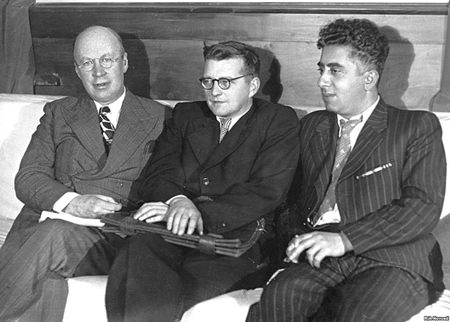Many years ago, when I got a position playing cello in our district orchestra I found myself sitting next to another boy of about my age who was clearly from foreign parts. It turned out that his name was Paul, he played the cello and he came from Armenia. At the time I hadn’t a clue where Armenia was and was too polite to ask. I probably didn’t want to appear an idiot, either. I had some vague idea that it might be somewhere between North Africa and the Middle East but I must have been getting mixed up with somewhere else because it turned out that Armenia is nowhere near Africa. And in case you’re wondering, Armenia is actually a bit to the north-east of Turkey.
I mention all this by way of a cheery introduction because this week’s column is about the most renowned Armenian composer of the twentieth century who was also the composer of the first Armenian ballet, symphony, concerto, and film score. His name is Aram Khachaturian (katch-uh-TOOR-ee-uhn) and his compositions have been performed in almost every country of the world.
 The Big Three in 1940: (left-right) Sergei Prokofiev, Dmitri Shostakovich and Aram Khachaturian.
The Big Three in 1940: (left-right) Sergei Prokofiev, Dmitri Shostakovich and Aram Khachaturian.
If you ever saw Stanley Kubrick’s movie 2001: A Space Odyssey, you’ve heard the music of Khachaturian. If you ever watched the 1970s television series The Onedin Line, you’ve heard the music of Khachaturian. In fact, it would be very surprising if you had never heard any of his music. When I was a schoolboy, his Sabre Dance was tremendously popular and known to almost everyone. Even our dog knew it. He knew it so well that he could even dance to it.
Aram Khachaturian: Sabre Dance. Berlin Philharmonic cond. Sir Simon Rattle (Duration: 02:35; Video: 1080p HD)
Dating from 1942, this is Khachaturian’s best known and most recognizable piece with a distinctive middle section based on an Armenian folk song. It comes from his four-act ballet entitled Gayaneh and is set on a Georgian farm collective. By 1948 Sabre Dance had become an unlikely jukebox hit in the United States.
It was one of the most popular pieces of the twentieth century and been used in countless television programmes and at least two dozen movies. Despite the outrageous popularity of Sabre Dance, Khachaturian was officially denounced in 1948 as a “formalist” and his music dubbed “anti-people” by the monolithic Central Committee of the Communist Party, but so were other composers including Prokofiev and Shostakovich. However, the disapproval was short-lived and for most of his career, Khachaturian held several high posts in the Union of Soviet Composers. In Armenia today, Khachaturian is considered a “national treasure”.
Aram Khachaturian: Violin Concerto. Haik Kazazyan (vln), Moscow State Symphony Orchestra cond. Pavel Kogan (Duration: 36:19; Video: 480p)
This work dates from 1940 and was dedicated to the Russian violinist David Oistrakh, who gave the first performance in Moscow. Oistrakh acted as adviser to Khachaturian on the writing of the solo part which is probably why the music seems to fit the instrument so well. It has since become a standard work in the violin repertoire.
After a brief orchestral introduction, the soloist launches into a scampering theme that sounds like Shostakovich but throughout the concerto, you’ll notice the Eastern European influence in the themes that follow. There’s some brilliant virtuosic writing which makes this concerto something of a challenge even for the most accomplished professionals.
The reflective, moody second movement also has elements of Eastern European music and contains some beautifully expressive violin writing, while the third and final movement opens with a lively orchestral fanfare and at times has the flavour of an Armenian country dance. Throughout the work you’ll hear the composer’s personal and distinctive musical voice.
Aram Khachaturian (1903-1978): Masquerade Suite. Japan Sinfonia cond. Hisayoshi Inoue (Duration: 21:04; Video 480p)
And so to lighter fayre. In 1941 Aram Khachaturian was asked to write the incidental music for a production of the play Masquerade by the famous Russian poet, painter and playwright Mikhail Lermontov. The plot involves a grand masquerade ball, an expensive bracelet and a poisoned ice-cream but you don’t need to know the intricate details to enjoy the music. It was first performed in Moscow the same year but in 1944 the composer converted some of the incidental music into this well-known five-movement suite for orchestra.
The opening movement, a swirling, hypnotic Russian waltz in the minor key is central to the work but although its composition evidently gave Khachaturian some difficulty it has become well-known in its own right and you’ll probably recognise the distinctive waltz melody. It’s followed by a brooding Nocturne, a lilting Mazurka, a magical fairy-tale Romance and finally a rousing Galop that could have made a good soundtrack for a Keystone Cops movie.




